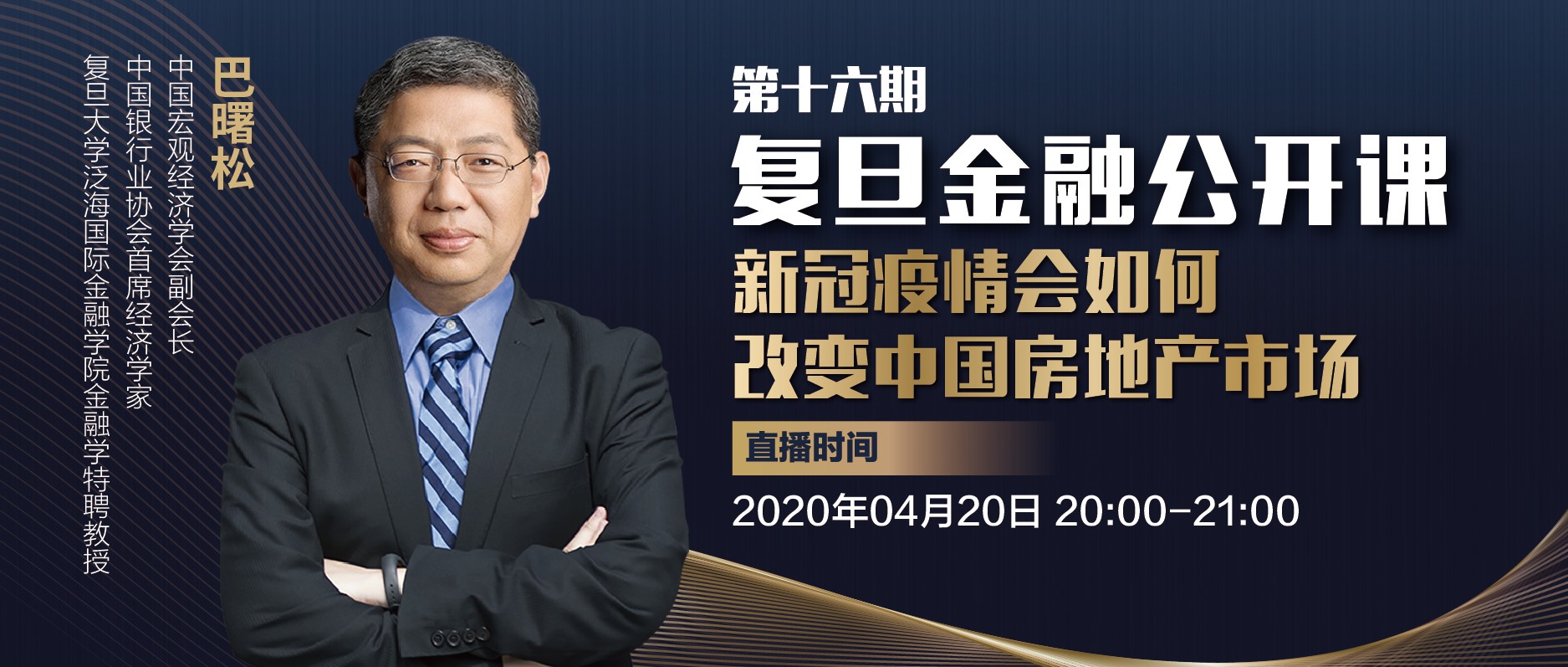
-
 86-21-63895588
86-21-63895588
-
 No.1, Lane 600, Nanchezhan Road, Huangpu District, Shanghai 200011
No.1, Lane 600, Nanchezhan Road, Huangpu District, Shanghai 200011
Release time:2020-04-21

On April 20, 2020, invited by Shang-Jin Wei, Academic Visiting Professor at the Fanhai International School of Finance (FISF), Fudan University and Chair Professor of Finance and Economics at Columbia University, Ba Shusong, Special-term Professor of Finance at FISF, Vice President of the China Society of Macroeconomics and Chief Economist of the China Banking Association, joined the Fudan Finance Open Course to discuss the impact of COVID-19 on the Chinese real estate market. The course, streamed live on Toutiao, Fudan Financial Review’s official TikTok account, Phoenix Finance, Sina Finance channel, Sina Finance APP, Baidu APP, Tencent News, China Business network, and other platforms, attracted over 2.35 million simultaneous viewers.
Prof. Ba Shusong started off with the transformation and development of the real estate market, and he paid special attention to the new trends in the current Coronavirus crisis. He pointed out that the Chinese real estate market would gradually bid farewell to high growth and would rather enter a state of equilibrium. Under siege due to the epidemic, China’s housing market is facing escalating inventory pressure and debt repayment strains, caused by the long-term domestic business model, characterized by substantial leverage and high growth.
Looking ahead, Prof. Ba alerts that attention should be paid first, to the possibility of capital and debt risks that may arise while companies adjust to the new market realities; second, to the implementation of policies to ensure the stability of the trading market; third, to the potential demand for some new policies driven by the construction of urban agglomerations in central cities; and fourth, to the transformation of old residential areas that might become a new investment opportunity in the near future.
Next, Prof. Shang-Jin Wei turned to analyzing the cyclical and structural impact of the pandemic, the Sino-U.S. trade frictions, and other aspects, which were examined in the conversation.
According to Prof. Wei, the epidemic has a cyclical and structural impact on the real estate market. In the short term, many trading activities were postponed or even canceled due to the virus outbreak. In the longer run, structural factors such as the rising income uncertainty of the private sector, the changing population gender ratio, and the introduction of relevant government policies would have a more sustained effect. Thus, when taking policy decisions regarding the housing market, it is crucial to distinguish between the short- and long-term factors. Professor Ba Shusong added that some of the pre-existing trends in the real estate industry were further intensified by the epidemic crisis. How to differentiate which changes are caused by the virus outbreak and which are alterations of the original trend, is a topic that deserves special attention.
Furthermore, Prof. Shang-Jin Wei suggested that the Sino-U.S. trade relations might have repercussions on the Chinese real estate market. He pointed out that since the impact of the China-U.S. economic and trade relations is relatively stronger on the coastal areas compared to the inland ones, this might affect the structure of regional development. Prof. Ba concurred and clarified: “If China starts to rely less on foreign trade and shifts to the expanding domestic demand, there will be no such obvious distinction between trade and non-trade sectors in the national market, also, there will be less excess liquidity caused by the foreign exchange. Moreover, it is likely that the pressure of rising housing prices will vary regionally.”
On the subject of such possible regional differentiation, Prof. Wei underlined that national policies, such as liquidity management, measures to support small and medium-sized enterprises, etc., might have a convergence effect on the property market. In addition, policies that encourage population mobility might further increase the differences between first- and second-tier cities, especially the variances between first-tier and other cities. Prof. Ba Shusong added that at present, the stage of building urban agglomerations around central cities, driving the development of surrounding cities, have been reached. This progress would depend on which cities would have the vision and ability to break through administrative divisions and be open for future cooperation. In the future, metropolitan areas will be the main carrier of urbanization in the country and the chief source of vitality for the domestic real estate market.